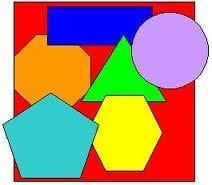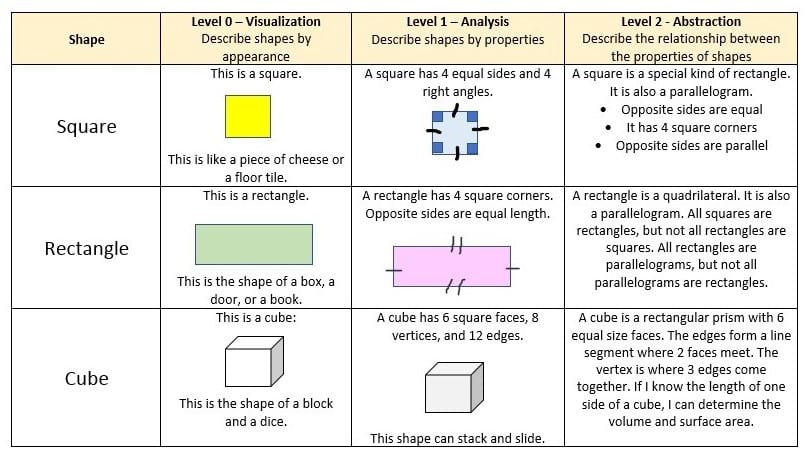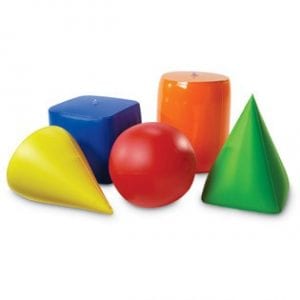by C. Elkins, OK Math and Reading Lady
Today’s post will focus on an aspect of geometry involving levels of thought. We know PreK or KG students aren’t ready for formal definitions regarding shapes. Starting about 2nd grade, students might be ready to describe shapes using specific attributes. Pierre and Dina van Hiele are Dutch math educators who have an excellent way to describe how children move through these geometric thinking levels. They are called “The van Hiele Levels of Geometric Thought.” Click on this link for a full description: The van Hiele Model Also – some good resources at the end of this post.
I became interested in these levels as I was doing research about better ways to help students master standards in Geometry. (See more information below regarding these levels.) Am I supposed to teach them the “proper definition” of a square in KG? At what point should students begin to understand the specific properties of a square – that it is actually a specific type of rectangle. And . . . when is it appropriate to help students realize that a square is also classified as a rhombus, rectangle, parallelogram, and quadrilateral? Click on the link for a pdf copy of the chart below: van Hiele Levels 0, 1, 2

What can we as teachers do to help them move through the levels? According to van Hiele, the levels can’t be skipped – children must progress through each hierarchy of thought. So while there is no grade level attached to these levels, I like to think of the Visualization Level as the beginning point most appropriate for PreK-1st or 2nd grade students. Level 1 thinking might surface in grade 2 or 3 (and up). Students capable of Level 2 thinking may start with 3rd – 8th grade. Students in high school geometry might function at Level 3 thinking.
One of the properties of the levels he described has the name of “Separation.” The article linked above states: A teacher who is reasoning at one level speaks a different “language” from a student at a lower level, preventing understanding. When a teacher speaks of a “square” she or he means a special type of rectangle. A student at Level 0 or 1 will not have the same understanding of this term. The student does not understand the teacher, and the teacher does not understand how the student is reasoning. The van Hieles believed this property was one of the main reasons for failure in geometry. Teachers believe they are expressing themselves clearly and logically, but their Level 3 or 4 reasoning is not understandable to students at lower levels. Ideally, the teacher and students need shared experiences behind their language.
Here’s a closer look at the levels.
Level 0 Visualization: Describe shapes on the basis of their appearance.
- In this level, it’s okay for the teacher to say, “This is what a square looks like.” (without describing the properties).
- Sort and classify shapes based on appearance “These go together because they are all pointy.” or “These all have square corners.” or “These have curves.” or “These have the same shape as a cookie.” or “All of these shapes roll.” or “This looks like a triangle with the top cut off (trapezoid).”
- Students work to group shapes that look alike.
- Student actions: observe, feel, build, sort, take apart, put together (using 2D and 3D models, pattern blocks, paper shapes, and pictures)
Level 1 Analysis: Describe shapes on the basis of their properties.
- Students learn what properties each shape has. Example: “All rectangles have 4 sides with opposite sides equal and parallel, and 4 right angles.” or “Perpendicular lines form a right angle.”
- There may be many ways to orient a shape, and the shapes may be different sizes (without changing the name of the shape).
- Student actions: describe and sort models and pictures based on properties
Level 2 Abstraction: Recognize the relationships between the properties of geometric shapes.
- Students realize some shapes can be classified different ways. Example: “A square is a special kind of rectangle.” or “All rectangles are parallelograms.” or “Perpendicular lines are a specific type of intersecting lines.” or “Rectangles are parallelograms with right angles.” or “If a shape is a quadrilateral with 4 equal sides and no right angles, it is a rhombus.”
- Student actions: Sort, classify, draw, and construct 2D and 3D shapes
The following 2 levels usually encompass thinking involved in high school, so I will not provide more details on these in this post.
Level 3 Deduction: Move from thinking about properties to reasoning or proving theories.
Level 4 Rigor: Establish and analyze theorems in different postulation systems.
Geometry Resources
- FREE 2D and 3D clipart — great for making your own worksheets or for kids to sort (Jen Hart Design @ TPT)
- FREE 3D shapes for sorting or graphing by srenaud @ TPT
- FREE Geometry Task Cards (a Level 1 or 2 activity) by Kathryn Willis @ TPT
- Pattern block compose shapes task cards – simple (composing larger shapes using pattern blocks) $2 by Kelly Smith @ TPT
- Lines and Angles Posters and Task Cards(Level 1 or 2 – attributes of different lines and angles) $2.50 by Kimberley Miner @ TPT
- 2D Shape Sorting Mats $2 by Little Academics @ TPT
- Movin’ it Match 2D and 3D Shapes bundle ($8 by The Math Maniac): Well worth it in my opinion especially if you are looking for lots of black line drawings of 2D and 3D shapes to use for sorting and games.
For those of you interested in more of van Hiele’s theory and specific ways to apply to different topics within Geometry, here is another article: van Hiele Model of Geometric Thinking (Ohio Dept. of Education)
I know this post doesn’t focus too much on lesson ideas – BUT it is a very important regarding developmental levels of geometric understanding. More lesson ideas to come.
Amazing resources! I am printing some of them and putting them in my arsenal! 🙂